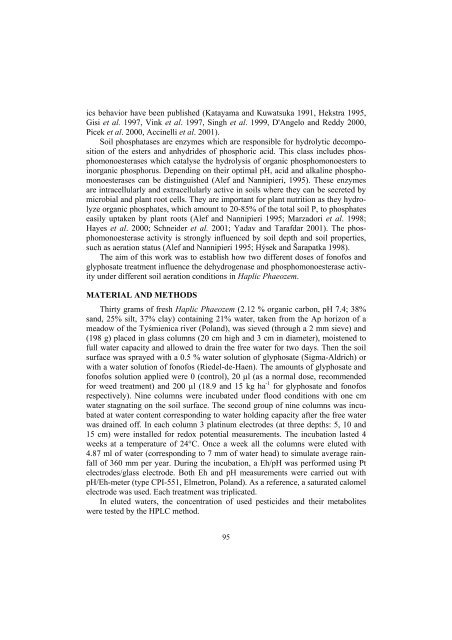soil - Lublin
soil - Lublin
soil - Lublin
Create successful ePaper yourself
Turn your PDF publications into a flip-book with our unique Google optimized e-Paper software.
ics behavior have been published (Katayama and Kuwatsuka 1991, Hekstra 1995,<br />
Gisi et al. 1997, Vink et al. 1997, Singh et al. 1999, D'Angelo and Reddy 2000,<br />
Picek et al. 2000, Accinelli et al. 2001).<br />
Soil phosphatases are enzymes which are responsible for hydrolytic decomposition<br />
of the esters and anhydrides of phosphoric acid. This class includes phosphomonoesterases<br />
which catalyse the hydrolysis of organic phosphomonoesters to<br />
inorganic phosphorus. Depending on their optimal pH, acid and alkaline phosphomonoesterases<br />
can be distinguished (Alef and Nannipieri, 1995). These enzymes<br />
are intracellularly and extracellularly active in <strong>soil</strong>s where they can be secreted by<br />
microbial and plant root cells. They are important for plant nutrition as they hydrolyze<br />
organic phosphates, which amount to 20-85% of the total <strong>soil</strong> P, to phosphates<br />
easily uptaken by plant roots (Alef and Nannipieri 1995; Marzadori et al. 1998;<br />
Hayes et al. 2000; Schneider et al. 2001; Yadav and Tarafdar 2001). The phosphomonoesterase<br />
activity is strongly influenced by <strong>soil</strong> depth and <strong>soil</strong> properties,<br />
such as aeration status (Alef and Nannipieri 1995; Hýsek and Šarapatka 1998).<br />
The aim of this work was to establish how two different doses of fonofos and<br />
glyphosate treatment influence the dehydrogenase and phosphomonoesterase activity<br />
under different <strong>soil</strong> aeration conditions in Haplic Phaeozem.<br />
MATERIAL AND METHODS<br />
Thirty grams of fresh Haplic Phaeozem (2.12 % organic carbon, pH 7.4; 38%<br />
sand, 25% silt, 37% clay) containing 21% water, taken from the Ap horizon of a<br />
meadow of the Tyśmienica river (Poland), was sieved (through a 2 mm sieve) and<br />
(198 g) placed in glass columns (20 cm high and 3 cm in diameter), moistened to<br />
full water capacity and allowed to drain the free water for two days. Then the <strong>soil</strong><br />
surface was sprayed with a 0.5 % water solution of glyphosate (Sigma-Aldrich) or<br />
with a water solution of fonofos (Riedel-de-Haen). The amounts of glyphosate and<br />
fonofos solution applied were 0 (control), 20 µl (as a normal dose, recommended<br />
for weed treatment) and 200 µl (18.9 and 15 kg ha -1 for glyphosate and fonofos<br />
respectively). Nine columns were incubated under flood conditions with one cm<br />
water stagnating on the <strong>soil</strong> surface. The second group of nine columns was incubated<br />
at water content corresponding to water holding capacity after the free water<br />
was drained off. In each column 3 platinum electrodes (at three depths: 5, 10 and<br />
15 cm) were installed for redox potential measurements. The incubation lasted 4<br />
weeks at a temperature of 24°C. Once a week all the columns were eluted with<br />
4.87 ml of water (corresponding to 7 mm of water head) to simulate average rainfall<br />
of 360 mm per year. During the incubation, a Eh/pH was performed using Pt<br />
electrodes/glass electrode. Both Eh and pH measurements were carried out with<br />
pH/Eh-meter (type CPI-551, Elmetron, Poland). As a reference, a saturated calomel<br />
electrode was used. Each treatment was triplicated.<br />
In eluted waters, the concentration of used pesticides and their metabolites<br />
were tested by the HPLC method.<br />
95

















